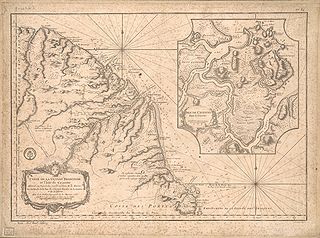
The history of French Guiana dates back to the period prior to European colonization. Prior to the arrival of the first Europeans, there was no written history in the territory. It was originally inhabited by a number of Native American peoples, among them the Kalina (Caribs), Arawak, Galibi, Palikur, Teko, Wayampi, and Wayana. The first Europeans arrived in the expeditions of Christopher Columbus, shortly before 1500.

Kourou is a commune in French Guiana, an overseas region and department of France in South America. It is an administrative district in French Guiana and the main town there.

Cacao is a town in French Guiana, lying on the Comté river to the south of Cayenne. Most of the town's population are Hmong farmers, refugees from Laos who were resettled in French Guiana in 1977. The reasoning was that living, and working conditions were similar to their native land. As of 2007, the village had a population of 750 people.

Saint-Laurent-du-Maroni (French pronunciation: [sɛ̃ loʁɑ̃ dy maʁɔni] is a commune of French Guiana, an overseas region and department of France located in South America. Saint-Laurent-du-Maroni is one of the two sub-prefectures of French Guiana and the seat of the Arrondissement of Saint-Laurent-du-Maroni. It is the second most populous city of French Guiana, with 45,576 inhabitants at the January 2018 census.

Saül is a commune of French Guiana, an overseas region and department of France located in South America.

Awala-Yalimapo is a commune on the north coast of French Guiana, close to the border with Suriname. The seat of the commune is the settlement of Awala where the town hall is located. Other settlements in the commune are: Yalimapo, Ayawande, and Piliwa. The majority of the inhabitants are Kaliña Amerindian people.

Iracoubo is a commune on the coast of French Guiana, an overseas region and department of France located in South America].

Camopi is a commune of French Guiana, an overseas region and department of France located in South America. Camopi is mainly inhabited by Amerindians of the Wayampi and Teko tribes.
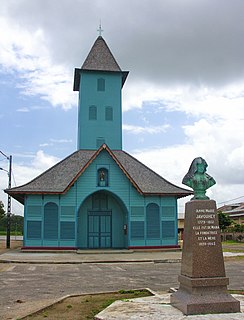
Mana is a commune and town in French Guiana. It was founded on 16 August 1828 by Sister Anne-Marie Javouhey. It borders the river Mana, from where it gets its name; and is nearby the river Maroni. Mana is the primary producer of rice in French Guiana, which it exports to Suriname.
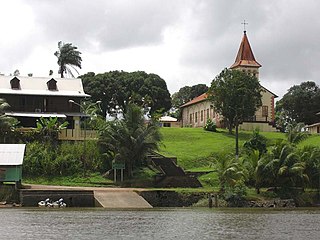
Roura is a commune of French Guiana, an overseas region and department of France located in South America. The city of Roura is bordered by Matoury and Montsinéry-Tonnegrande in the North, Kourou and Saint-Elie in the North West and West, and finally by Régina in the South and East.
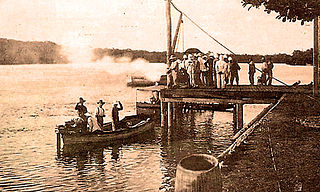
Saint-Jean-du-Maroni is a village in French Guiana, in the commune of Saint-Laurent-du-Maroni on the river Maroni. The village is mainly inhabited by Ndyuka Maroons.

Articles related to the French overseas department of Guiana(Région Guyane) include:

French Guiana is an overseas department/region and single territorial collectivity of France on the northern Atlantic coast of South America in the Guianas. It borders Brazil to the east and south and Suriname to the west.

The St. Lawrence Church is a religious building that serves as a parish church dependent on the Diocese of Cayenne which was created by pope Pius XII with the Bull "Qua sollicitudine" in 1956.
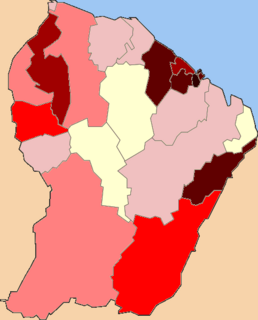
The COVID-19 pandemic was confirmed to have reached the French overseas department and region of French Guiana. The first five cases were found on 4 March and the first death was announced on 20 April 2020. On 30 April, the territory was green listed, because the pandemic appeared to be under control except for St-Georges de l'Oyapock. In June, the virus started circulating all over the territory.

Acarouany is a village in the Mana commune of Saint-Laurent-du-Maroni in French Guiana. Acarouany was the location of leper colony between 1833 and 1979. From 1989 until 1992, it was the location of a Surinamese refugee camp. The village is located on the Acarouany River.

Charvein is a village in the Mana commune of Saint-Laurent-du-Maroni in French Guiana. Charvein was the location of Camp Charvein, one of the most notorious camps of the Prison of St-Laurent-du-Maroni. From 1989 until 1992, Charvein was the location of a Surinamese refugee camp.

Sainte-Rose-de-Lima is a village of Lokono Amerindians in the commune of Matoury in French Guiana. The village is located on the RN2 near Cayenne – Félix Eboué Airport. It is the largest settlement of Lokono in French Guiana.
















